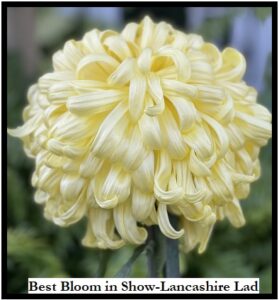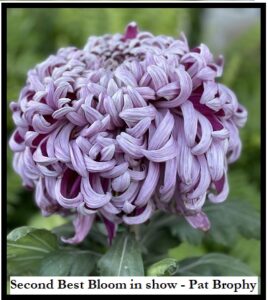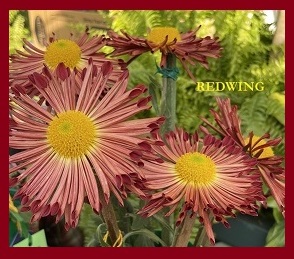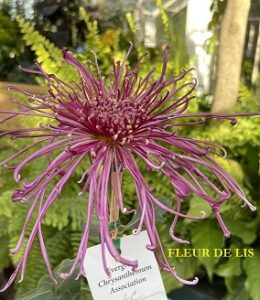EVERGREEN CHRYSANTHEMUM ASSOCIATION
Seattle, Washington
ECAMumClub.org
Email us at: steve at ecamumclub dot org
HAPPY SPRING !
MEETING OF THE ECA – THURSDAY MAY 9th, 2012 at 7 PM at the Seattle Police Athletic Association Office (SPAA) site; 11030 East Marginal Way South, Tukwila.
EXTENDED SOLICITATION
This is your monthly newsletter and as such, it is only as good as the information put
forward through it to the club members. I am asking for input from all members and not just the officers from now forward to get as much pertinent info as possible to all club members. For those of you who do not have email, please pass info on to one of the officers or e-mail Steve Joyner.
PLANT SALE RESULTS
Here is a summary from Mark Ross on plant sale revenue:
For the Furney sale, we took in $1,056 ($215 from members and $841 from the public). We also sold another $172 to members at the April meeting to up the total to $1,228 for the month. This plus the plant sale revenue from February and March puts the club sales over $1,500 for the year. There are still some plants that will come to the meeting next month and on to the Des Moines garden club sale Mothers Day weekend that will nudge the total up a bit more.
YEARBOOKS
Mark Ross may or may not have the yearbook ready for distribution this month. If not finished, the yearbooks will distribute and mail in June.
PLANT CULTURE and SUPPLIES
Gary Budzeak, Don Stark and John Harden are responsible for the club supply orders. Please contact one of them for soilless and supply needs at the April meeting.
If we are mailing you the monthly notice and you have an email address, please send an email to Steve Jpyner with your email address.
TO DO LIST for May and June (revised DRS 4/25/05)
Stopping:
Most plants are stopped April 15 through June 1, including the Early English classes. Keep your stop list handy and follow it rigorously. The calendar doesn’t move backwards. For #1 and #2 varieties the English literature recommends a fairly hard pinch; that is pinching 6-8 leafs down from the growing tip. For the incurves, #3, #13, #23 pinch the smallest portion of the growing tip to get more uniform growth of the laterals. For all varieties, fertilize 1-2 weeks before pinching to produce more laterals. This is especially true for the Fairweathers.
Final Potting into 8”, 9” or 10” pots. (Or maybe in the garden soil)
Preparation:
Wash pots (in mild Clorox solution) then rinse in clear water.
Prepare potting mix. – Soilless (M&R) users; add another 5-10% of screened pumice or Perlite to improve drainage. Also at this final stage, I recommend adding Cedar Grove compost or other fresh compost and a small amount of well-composted horse manure. This results in a mix of 6 parts M&R soil less, 4 parts compost, 1 part pumice, and small amounts of horse manure and Alfalfa meal. ater plants in the 6” pots 1 day before repotting.
Potting (Pot on when the ring of roots around the bottom of the pot is semi root bound.) Cover drain holes in bottom of clay pots with a piece of broken crock to keep drain clear. Put a layer of broken sod or course pumice in the bottom of pot, then cover with 1 or 2 inches of the final (9”) mix. Place the 6” root ball on top of the 9” mix and fill around with the 9” mix. The top of the root ball should be 1+ inch below the top of the pot. Do not pack the mix except as necessary to hold the plant and stake in place. Stake with shingle or bamboo stick.
Add Marathon Systemic at this time to control black aphids. Sprinkle ½ tspn. Marathon on top of soil when repotting plant, add a thin layer of mix over the top, then water moderately.
Note: When potting on occurs after June 1, Consider dropping down one pot size because the roots will not have time to fill the bigger pots. # 1 & #2 cultivars, 9” max, 8” could be used. #3s, 8” max.
Feeding and pest management
· After 3 weeks in final pot start summer feeding program.
1 to 2 tsp. 20-10-20 per gallon water, once a week.
Note: Some plants will thrive with the heavier solution, while others may not like so much fertilizer. Watch the leaves to gauge the fertilizer needed. If leaves become hard and curl up you are overfeeding. If leaves are somewhat weak and lighter green then more fertilizer would help.
· If plants are yellowish, first try drying them out. If drying the plant is unsuccessful, feed ½ tsp. Epsom Salts per plant. Leaf feeding of liquid iron such as Greenall or Sequesterine also helps green up the plant. Follow product directions. Do not over feed Liquid Iron.
· Review your pest management program every 2 weeks,
Marathon systemic is the most effective black aphid control.
Diazinon and most rose insecticides are somewhat less effective, and require spraying every 2 weeks, as they are contact insecticides. Spray every two weeks with a fungicide. Ortho Funginex or Daconil is recommended. Other fungicides will work well if used regularly. If fungus gets away and is growing fast, a fungicide used to control early blight in tomatoes will really shut it down.
4. Lateral Control
As side laterals develop after the final pinch, select the number of laterals to carry through the summer and remove all other side shoots. Generally the topmost lateral below the stem break is removed, as it is the weakest lateral structurally and easily broken off by accident. At this early stage you should carry 1-2 more lateral than you want at the bloom stage. An old saying goes: “I grow 2 for me and one for the bug.”
Surplus laterals are removed later in the summer using the following guide.
For #1 & #2 cultivars, carry 2 or 3 laterals initially, cull to 1 or 2 in Aug.
For #3 cultivars, carry 5 laterals and cull Sept. or Oct.
For #4 & b#5 cultivars, carry 4 to 5 laterals and cull to 2 to 3 in Sept.
For Earliers (13-15 and 23-25) carry 4-5 laterals and cull to 2-3 in Sept.
For Spiders, Quills, Spoons, Singles etc. follow the guide for #4 and #5.
Note: Cutting back to the few laterals seems to be a most difficult task for the novice. You must do it however if you wish to get large blooms.
5. Staking.
By now all plants will require staking. A 16-24 in. stake should be placed along the main plant stem and tied to it to support and protect the plant. As the side laterals develop it will be necessary to add longer stakes that can support each lateral all the way to bud development. Care must be exercised so as to not spread the new laterals too far apart when staking, as one or more could be broken off. In other words let the laterals grow till they can be easily tied to the new stakes.
Note on staking: Many of you use Bamboo stakes to support the stem in early stages. These stakes are round and tend to rotate in wind, movement etc. Leaving a sizable hole at the top. Don Stark seriously recommends using rectangular (wooden) stakes as these tend to hold their original position and not open up a hole.




